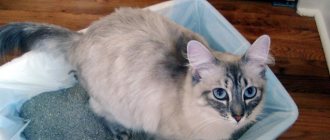When a pet's health fails, owners do not always show concern when trying to treat the animal at home. If your cat's hind legs begin to fail, this is a reason to immediately contact a veterinarian.
The reason for limb failure may be a serious illness or injury that requires immediate treatment. Slowness can be fatal. Any gait disturbances, paralysis, or spinal injuries in an animal cannot be cured on your own.
Failure to contact a veterinarian in a timely manner greatly increases the risk of complete loss of sensitivity and mobility of the paws.
So, the cat’s hind legs are failing, causes, signs, treatment, prognosis.
Hind paw failure: the most common causes
Loss of limb mobility can occur for a variety of reasons. It is extremely difficult for an animal owner to make a diagnosis on his own; a trip to a veterinary clinic will help to adequately assess the condition of a sick cat, completely cure and restore the pet.
- Spinal column injuries.
The hind limbs lose mobility due to spinal injuries. Particular attention should be paid to the lumbar region. A cat walking on the streets can get injured.
The spine can be damaged when hit by a car, bicycle, motorcycle, or falling from a tree or fence. Cats living at home can also injure their spinal column by falling from a ledge or cabinet. Symptoms: the pet drags its back, the tail is motionless, the cat feels weak.
- Thrombus in the femoral artery.
When the femoral artery is blocked (thromboembolism), the pet gradually loses sensitivity in the limbs, the cat suffers from severe pain in the lumbar region, screams, and tries to bite the lower back. Tissue necrosis that accompanies the blockage process leads to complete failure of the hind legs.
Timely therapy provided to the pet in the first hours can lead to complete recovery of the body. Inaction on the part of the owner will result in the painful death of the animal in 3-4 days.
- Tick bite.
Be sure to read:
Why does a cat lick under its tail until it becomes bald - it can be dangerous!
An ixodid tick bite leads to paralysis and subsequent death. The pathological condition is as follows: after the bite, the cat becomes excited, later the animal begins to feel severe weakness, apathy, continuous trembling spreads throughout the body, and paralysis begins.
Therapy should begin when the pet is excited, otherwise it will be too late.
- Myelitis.
Myelitis (inflammation of the spinal fluid) can develop as a result of infectious diseases, worms, poisoning with harmful substances, or injury.
The pathology is accompanied by the following symptoms: loss of paw mobility, chaotic movements, elevated body temperature, vomiting, diarrhea, involuntary urination. Timely therapy will lead to complete restoration of sensitivity.
- Pathology of the hip joint.
With hip dysplasia, the correct formation of bone tissue is disrupted. Large breed cats are susceptible to the disease.
The pathology causes severe pain when walking, it is difficult for the cat to jump, and the gait changes over time. Without supportive care, the disease can lead to hind leg failure.
- Stroke.
Motor activity may disappear due to a stroke. Blood clots can be present in both an elderly pet and a young pet due to poor diet and sedentary lifestyle.
Blockage of blood vessels in the brain leads to paralysis of the limbs. The sooner the pet owner notices the attack and begins treatment, the greater the chance of a full recovery.
- Heart failure.
Improper heart function can lead to loss of paw mobility. A diseased organ does not provide the required amount of oxygen to the body, resulting in muscle atrophy. Associated symptoms: the appearance of shortness of breath, dry cough, lethargy.
Back or brain injury and their consequences
The cat has a swollen paw and is limping: what to do?
Unfortunately, more severe injuries resulting from cats falling from a great height (from a balcony, roof) are fraught with bruises, concussion of the brain and spinal cord with subsequent neurological disorders. In addition, they may be accompanied by numerous fractures of the musculoskeletal system.
For your information! A strong blow to the head leads to the destruction of brain cells, and the hypothalamus and brain stem may be damaged. In especially severe cases, cerebral hemorrhages and tissue necrosis occur.
When the spinal cord is contused, a disruption in the functioning of the musculoskeletal system occurs, the animal limps or completely loses the ability to move. Vomiting occurs, the pupils often have different sizes, and they react poorly or not at all to light. The cat begins to spontaneously shake its limbs. The head may fall back, and the pet may lose consciousness or fall into a coma.
Important! The cat's symptoms and behavior depend on how severely the animal is injured. In severe forms with rupture of the spinal cord membranes, the sensitivity of the limbs and tail is completely lost.
If the cat is unconscious or in shock, under no circumstances should you shake it or apply ammonia to its nose. You need to make sure that the tongue is not stuck and take it to the veterinarian in your arms. Only a specialist can assess the degree of concussion. Depending on the situation, he will give the necessary injections of antibiotics and sedatives. In some cases, the use of medications to support heart function will be required. The doctor will give the necessary recommendations for care and treatment. The recovery of a cat is long, up to 4-8 weeks or more (depending on the age of the animal and the severity of the condition).
The presence of serious diseases that cause lameness can only be detected by a veterinarian
Signs of limb failure
Symptoms to pay close attention to:
- Complete or partial impairment of motor function. The cat stops moving quickly, drags its limbs, and moves by crawling.
- Changes in gait. “Wobbling” of a small kitten is a normal phenomenon; a similar situation with an adult animal should alert the owner.
- Amyotrophy . Muscles lose elasticity.
- Pain on palpation of the hind limbs. The animal screams in pain if the back of its body is touched.
- Lack of sensitivity. The animal stops feeling heat and cold with its paws.
Be sure to read:
Seizures in a cat: physiological and pathological causes, symptoms, first aid, treatment
Possible reasons
There are many reasons why a pet's hind legs fail. It is quite difficult to identify them, so you need to remember everything that your pet has interacted with recently. What did you eat, where did you go, etc.
. Even a seemingly harmless ear mite can cause such a terrible disease.
In this article we will present only those common reasons why paralysis may occur . There are quite a lot of them, so under no circumstances do the diagnosis yourself; entrust it to a professional who has already encountered the disease and knows what to do and how to restore a full life to your pet.
Spinal injuries
The most obvious and common is a dislocation, a fracture of the cat's spinal cord. Most paralysis is sudden, hollow and bilateral. In such an unfavorable situation, symptoms appear almost immediately. In case of serious injury and bruise, it may be accompanied by painful shock and loss of consciousness. Unfortunately, it is very rarely possible to fully recover from this.
Spinal cord inflammation
Due to poisoning, toxins in the body, or some kind of infection, the cat may lose its hind legs. This is also accompanied by incontinence, increased temperature, fever, etc. If you follow the doctor’s instructions, recovery is more than possible, and the prognosis is most often favorable.
Thromboembolism
Occurs due to impaired blood supply. Due to blockage of blood vessels by blood clots (a piece of tumor or a parasite), tissue death occurs. Because of this, the cat screams in pain, shock, decreased blood pressure and heart rate, respiratory rate, and increased temperature. The disease develops gradually and what is important here is how quickly the owner responded to the symptoms and how quickly he called the veterinarian.
Stroke
Symptoms and signs include fainting, shock, confusion about where the cat is, lethargy and apathy. Along with the paws, there may be paralysis of the pharynx, which causes choking and difficulty in eating food and swallowing in general. When a cat's hind legs fail after a stroke, the prognosis is favorable and the likelihood of improvement is high.
Fibrocartilaginous embolism
In other words, this is tissue death. It is most often caused by blockage and disruption of the blood vessels of the cat’s spinal cord. The disease develops at lightning speed, begins with the cat screaming in pain, followed by laziness, apathy, lack of playfulness, reluctance to walk, react to other stimuli from the owner, reluctance to eat, after which comes the final stage, when the paws finally die. Here everything is more complicated and the prognosis can be both favorable and not.
Tick paralysis
Ticks are a big problem for both people and animals. Their poison and toxins kill the body from the inside within a few days. It is very important to consider the symptoms and stages, because the prognosis depends on them. At the beginning, the symptoms are invisible to the eye: pet agitation, anxiety and stress. After some time, apathy begins, a reluctance to move and go somewhere, playfulness disappears. Then the pet begins to feel poisoned in the body, he feels sick, he trembles, his temperature drops, his pulse decreases and his breathing shortens. At the last stage, paralysis of the hind legs and more already occurs. Paralysis may also occur in the larynx. Recovery is possible, but only in the first 2-3 stages, and not in the last, when the entire body of the animal is poisoned.
Cardiomyopathy
The volume of the ventricles in the heart decreases, the walls become denser. Because of this, activity deteriorates, appetite decreases, and complete apathy to surrounding stimuli. Attacks of vomiting and coughing also appear. Here it just seems like paralysis is piercing your paws. In fact, with such a disease, paralysis itself does not often develop. If they are completely eliminated, then there is a layering with other reasons, for example, thromboembolism or other blockages of any vessels in the cat’s body. If only cardiomyopathy occurs, then the prognosis for recovery is good.
Hernia
With a herniated spine, the cat refuses to move. Any touch to an animal brings pain. If a cat walks, it bends strongly, its head is lowered down. Most often, after surgery, the pet recovers quite quickly and asymptomatically.
Treatment
When the pet is brought to the veterinary clinic, the doctor:
- conducts an initial examination, determines the degree of sensitivity of the paws;
- prescribes an x-ray examination;
- conducts ultrasound of internal organs;
- takes the animal's blood and urine for analysis.
Treatment is prescribed after diagnosing the disease; therapy includes: medication, physiotherapy, paw massage, and in rare cases, surgery.
Physiotherapy for cats with leg paralysis
The recovery period after paralysis drags on for a long time; in this case, the animal owner cannot do without physiotherapy.
Veterinarians advise performing a daily set of exercises to help restore neurological functions.
- Passive movements. Place the cat on its back and move the paralyzed legs alternately in a circular motion for at least five minutes. The exercise is similar to riding a bicycle.
- Stimulating massage. Stretch your paw pads and limbs daily.
- Scratching. Scratch the paralyzed animal in different places; even with little progress, the cat will try to scratch with its hind paw.
- Using an inflatable ball. Place the cat on its stomach on the ball, so that its paws lightly touch the floor. Roll the ball while holding your pet back and forth.
- Using support. Pass a wide strip of fabric under your pet's belly and try to walk with the animal, holding the ends of the fabric.
- Moving limbs. Take the cat by the hind legs and slowly move them, imitating walking.
- Swimming. Make the cat swim in the bath every day, holding the animal so that it does not choke.
Be sure to read:
The cat has a fever: what to do, reasons, what is the norm, how to bring it down at home, the best methods
First aid for a cat
If you notice that your cat is limping, you need to immediately identify the cause. Having discovered a wound, the first thing to do is disinfect it. If possible, remove hair around the damage and rinse with furatsilin solution.
Limit access of dirt to the wound, apply a bandage and contact a veterinarian.
If you suspect a dislocation, sprain or fracture, provide your pet with maximum rest, give painkillers and cardiac medications, and call a doctor.
X-ray of the hind paw.
An x-ray must be taken at the clinic . If necessary, apply a fixing bandage. The fracture is fixed by applying a splint or plaster cast. Antibiotics and anti-inflammatory drugs are used.
Arthritis treatment
Treatment of arthritis includes taking antibiotics in the form of a dietary supplement - glucosamine, chondroitin.
Taking fish oil and painkillers. A light massage and daily short exercise are indicated. Animals with arthrosis are provided with dietary nutrition and comfortable living conditions.
Drug treatment - decongestants, anti-inflammatory drugs - in the presence of inflammation. Massage, Minin lamp therapy. For severe back injuries, the prognosis is, unfortunately, unfavorable. The animal experiences severe pain, and sometimes limb paralysis is observed.











